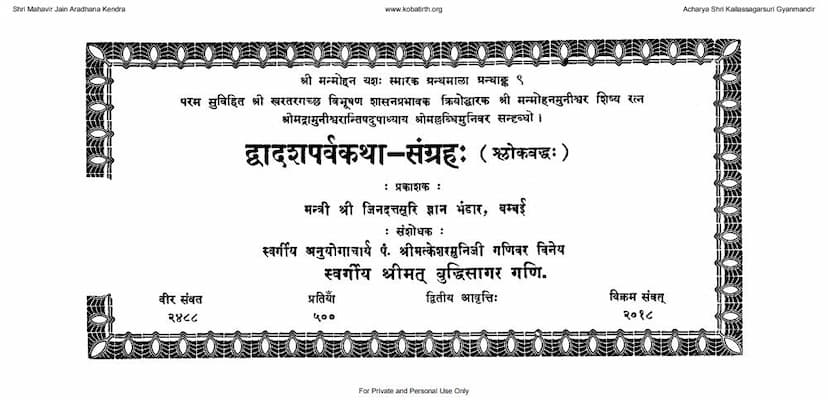Dwadash Parvkatha Sangraha
Added to library: September 1, 2025

Summary
This Jain text, "Dwadash Parva Katha Sangraha" (Collection of Tales of Twelve Festivals) by Labdhimuni and Buddhisagar Gani, published by Jinduttsuri Gyanbhandar, is a collection of stories explaining the significance and merits of various Jain festivals and observances. The book aims to educate and inspire followers by illustrating the spiritual benefits derived from adhering to these practices.
The text delves into the stories behind twelve significant Jain festivals (Parvas), providing detailed narratives and explanations for each. The core theme throughout the book is the power of devotion, penance, ethical conduct, and adherence to Jain principles in achieving spiritual liberation (moksha) and worldly well-being.
Here's a breakdown of the festivals and their associated themes as presented in the book:
-
Gyan Panchami Katha (Story of the fifth day of knowledge): This section emphasizes the paramount importance of knowledge (Gyan) in Jainism, stating that it leads to liberation and worldly happiness. The story likely illustrates how devotion to knowledge through practices like fasting and worship on Gyan Panchami purifies the soul and removes obstacles.
-
Kartik Purnima Katha (Story of the full moon of Kartik): This festival, celebrated on the full moon day of Kartik, is highlighted for its spiritual significance. The story likely connects the observance with attaining divine knowledge and spiritual merit, possibly through pilgrimage or specific penances.
-
Mauna Ekadashi Parva Katha (Story of the silent eleventh day): This festival focuses on the practice of silence (Mauna) observed on the eleventh day of the lunar fortnight. The story likely illustrates how maintaining silence, fasting, and other observances on this day can lead to the eradication of past karma and spiritual progress. The narrative of Suvrata Sheth is a significant part of this section, showcasing the transformative power of this vow.
-
Paush Dashami Parva Katha (Story of the tenth day of Paush): This festival, observed on the tenth day of Paush, is presented with a story emphasizing devotion to Lord Parshvanath. The narrative likely highlights how adherence to the rituals and vows associated with this day, including fasting and temple worship, brings prosperity and spiritual benefits.
-
Meru Trayodashi Parva Katha (Story of the thirteenth day of Meru): This section likely discusses the significance of the thirteenth day, possibly related to Meru mountain, a sacred site in Jainism. The story of King Pingal and his overcoming his physical affliction through devotion and penance on this day is a key element, emphasizing the power of faith and observances.
-
Holika Parva Katha (Story of Holika): Unlike the common understanding of Holika as a fire festival, the Jain perspective presented here likely reinterprets it as a spiritual "Holika" where karmic impurities are burnt through penance and righteous actions. The story might contrast the mundane celebration with the true spiritual meaning of purifying oneself from negative karma.
-
Chaitra Purnima Mahatmya (Glory of the full moon of Chaitra): This festival is presented as a time for spiritual reflection and devotion. The story likely connects the observance with the attainment of good fortune, overcoming past afflictions, and spiritual growth, possibly through pilgrimage to Shatrunjay.
-
Akshaya Tritiya Parva Katha (Story of the indestructible third day): This festival emphasizes the concept of "indestructible" merit gained through righteous actions. The story likely revolves around the principle of giving and devotion, illustrating how acts of charity and worship on Akshaya Tritiya yield lasting spiritual rewards. The narrative of Shreyans, who offered sugarcane juice to Lord Rishabhanatha, is featured.
-
Rohini Parva Katha (Story of Rohini): This section likely focuses on the festival of Rohini, emphasizing the importance of devotion to Lord Vasupujya. The story of Queen Rohini and her virtuous conduct, possibly involving specific vows or penances, is likely presented to highlight the benefits of following a righteous path.
-
Chaturmasi Parva Vyakhyana (Explanation of the Chaturmasi Festival): This section explains the significance of the Chaturmasi, a four-month period of increased spiritual discipline. It likely outlines the various observances and restrictions during this time for both ascetics and lay followers, emphasizing the importance of piety, austerity, and ethical conduct.
-
Paryushana Ashtahnika Vyakhyana (Explanation of the eight-day Paryushana): This is a major Jain festival focusing on penance, introspection, and self-purification. The text likely details the various rituals, fasting, and spiritual practices undertaken during Paryushana, emphasizing the importance of compassion (Abhaydan - fearlessness) and the purification of mind, speech, and body. The stories of King Aridaman and the importance of forgiveness are likely included.
-
Deepmalika Parva Mahatmya (Glory of the festival of lamps): This section likely explains the significance of Deepmalika, which is celebrated by illuminating homes and temples. The story might connect this practice with the remembrance of Lord Mahavir's nirvana or the attainment of divine knowledge, emphasizing the dispelling of spiritual darkness. The text also includes a detailed prophecy about the future decline of Jainism and the eventual resurgence, narrated through King Suryamitra's dreams.
Overall, "Dwadash Parva Katha Sangraha" serves as a guide to understanding and practicing Jain festivals, reinforcing the core values of the Jain faith and encouraging spiritual growth towards liberation. The book's emphasis is on the karmic consequences of actions and the positive outcomes that arise from sincere devotion and adherence to Jain teachings.